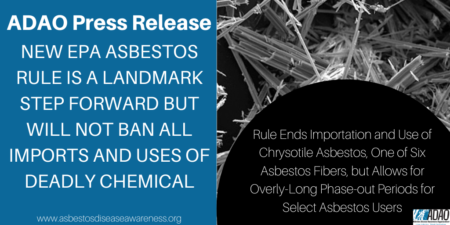FAQs and Quotes on EPA Part 1 Chrysotile Asbestos Rule
March 18, 2024 | 11:30 am ET
NEW EPA ASBESTOS RULE IS A LANDMARK STEP FORWARD BUT WILL NOT BAN ALL IMPORTS AND USES OF DEADLY CHEMICAL
Rule Ends Importation and Use of Chrysotile Asbestos, One of Six Asbestos Fibers, but Allows for Overly-Long Phase-out Periods for Select Asbestos Users
 Washington, D.C. — The Asbestos Disease Awareness Organization (ADAO), an independent nonprofit dedicated to preventing asbestos exposure through education, advocacy, and community work, today recognized the Environmental Protection Agency’s (EPA) final Part 1 rule prohibiting the importation and use of one type of asbestos — chrysotile— as a landmark step forward in the fight against this deadly chemical, but emphasized the rule’s limited scope will not fully protect Americans.
Washington, D.C. — The Asbestos Disease Awareness Organization (ADAO), an independent nonprofit dedicated to preventing asbestos exposure through education, advocacy, and community work, today recognized the Environmental Protection Agency’s (EPA) final Part 1 rule prohibiting the importation and use of one type of asbestos — chrysotile— as a landmark step forward in the fight against this deadly chemical, but emphasized the rule’s limited scope will not fully protect Americans.
“We commend EPA for finalizing the Part 1 rule banning the importation and use of chrysotile asbestos, one of six deadly asbestos fibers, for six conditions of use. Closing the door to chrysotile imports is a historic step, but the EPA rule does not restrict importation and use of five other recognized asbestos fibers,” said Linda Reinstein, co-founder and president of ADAO.
“Users of raw asbestos and asbestos-containing brake blocks and gaskets in the chlor-alkali, brake block, chemical and refining sectors will finally be required to transition to non-asbestos technology, but we are alarmed that the rule allows an unnecessarily long transition period and creates inconsistent compliance deadlines for certain asbestos users, which will allow dangerous exposure to chrysotile asbestos to continue for years to come,” she said.
A single chlor-alkali company imported over 300 metric tons of raw chrysotile asbestos into the United States in 2022.
The five asbestos fiber types not addressed by the rule are crocidolite, amosite, anthophyllite, tremolite, and actinolite. Advocates, scientists, unions, public health groups and asbestos victims have worked tirelessly to ban all six carcinogenic asbestos fibers since 1989 when an industry legal challenge voided EPA’s original asbestos rule.
“The limited scope of the EPA rule underscores that imports and use of asbestos will only end when Congress enacts a comprehensive asbestos ban that prohibits all six asbestos fibers and all cases of use. Congress must pass the Alan Reinstein Ban Asbestos Now Act (ARBAN) to pave the way for a future free from the tragedy of asbestos-related diseases,” said Reinstein.
“Without legislation, current and future exposure to asbestos fibers that have the same lethal properties as chrysotile can continue,” said Bob Sussman, ADAO counsel. “Congress can put a stop to this exposure by banning all six asbestos fibers now.”
When inhaled, microscopic asbestos fibers can become lodged in the lungs, irritating lung tissues. Exposure can cause asbestosis, pleural disease, lung cancer, mesothelioma, cancer of the larynx, ovary, and others.
From 1991 to 2021, more than one million Americans died from preventable asbestos-caused diseases. For more, read ADAO’s 2023 Comprehensive Asbestos Report: The Analysis of Imports, Use, Impact on Human Health, and Current Regulations and Policy.
###
About the Asbestos Disease Awareness Organization
The Asbestos Disease Awareness Organization (ADAO) was founded by asbestos victims and their families in 2004. ADAO is the largest non-profit in the U.S. that is dedicated to providing asbestos victims and concerned citizens with a united voice through our education, advocacy, and community initiatives. ADAO seeks to raise public awareness about the dangers of asbestos exposure, advocate for an asbestos ban, and protect asbestos victims’ civil rights.
